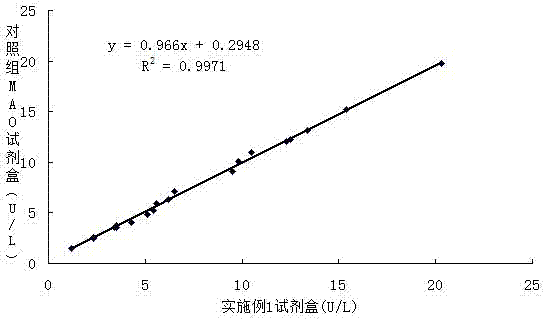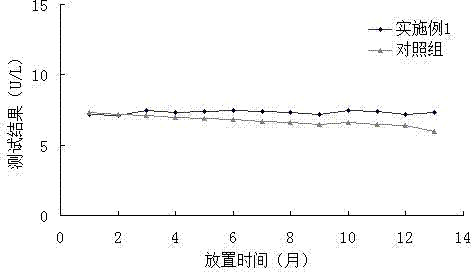Serum monoamine oxidase detection kit
A monoamine oxidase and detection kit technology, which is applied in the measurement of color/spectral characteristics and analysis by chemical reaction of materials, etc., can solve the problems of poor anti-interference ability, cumbersome operation, unsuitable automatic analysis, etc., so as to improve the accuracy of detection. performance, ease of use and operation, improved stability and anti-interference ability
- Summary
- Abstract
- Description
- Claims
- Application Information
AI Technical Summary
Problems solved by technology
Method used
Image
Examples
Embodiment 1
[0039] In the monoamine oxidase detection kit described in this embodiment, the reagent R is composed of the following components:
[0040] HEPES buffer (pH8.5) 100mM
[0041] Benzylamine 20mM
[0042] Alpha-ketoglutarate 10mM
[0043] Reduced coenzyme 0.25mM
[0044] Trehalose 5g / L
[0045] NaCl 1g / L
[0046] Glucose 5g / L
[0047] Glucose dehydrogenase 5U / L
[0048] Glutamate dehydrogenase 3KU / L
[0049] Lauryl dimethyl betaine 1g / L
[0050] BSA 2g / L
[0052] The method of using the monoamine oxidase detection kit in this embodiment is as follows: use a fully automatic biochemical analyzer, such as Toshiba 40 fully automatic analyzer, etc., and use the single reagent rate method for determination. Place the reagent R on the corresponding reagent position, and place the distilled water and the sample on the corresponding position of the sample plate. The operation is shown in Table 1.
[0053] Table 1 Example 1 reagent detection method
...
Embodiment 2
[0057] Interfering test
[0058] Take fresh mixed serum, divide it into 2 equal parts, and then divide each equal part into 5 equal parts, add different interfering substances, so that the concentration in the serum reaches the requirements in Table 2. Then the reagents obtained in Example 1 were used to compare and measure the content of MAO in serum at the same time as the common and recognized MAO reagents in the market. The results of the control group and the results of each group after adding different interfering substances are shown in Table 2. Relative deviation (%) = (measuring mean value of interference samples - measuring mean value of control samples) / measured mean value of control samples × 100%.
[0059] It can be seen from Table 2 that the reagent of Example 1 has no obvious interference on the test results when ascorbic acid ≤ 50 mg / dL, bilirubin ≤ 40 mg / dL, hemoglobin ≤ 200 mg / dL, ammonia ≤ 50 μmol / L. However, the reagents of other examples were significantl...
Embodiment 3
[0063] correlation experiment
[0064] The reagent was prepared using the formula of Example 1, and compared with the monoamine oxidase kit of a company approved by the State Food and Drug Administration, which is common in the market, the test was carried out. 20 clinical serum samples were tested at the same time, and the test results are shown in Table 5. And obtained the correlation curve of the two reagents (such as figure 1 Shown), the test results show that the correlation coefficient of the two kits is 0.9985, indicating that there is a great correlation between the two.
[0065] Table 3 Example 1 reagent and market common and recognized monoamine oxidase assay kit comparative detection results
[0066] .
PUM
 Login to View More
Login to View More Abstract
Description
Claims
Application Information
 Login to View More
Login to View More - R&D Engineer
- R&D Manager
- IP Professional
- Industry Leading Data Capabilities
- Powerful AI technology
- Patent DNA Extraction
Browse by: Latest US Patents, China's latest patents, Technical Efficacy Thesaurus, Application Domain, Technology Topic, Popular Technical Reports.
© 2024 PatSnap. All rights reserved.Legal|Privacy policy|Modern Slavery Act Transparency Statement|Sitemap|About US| Contact US: help@patsnap.com










